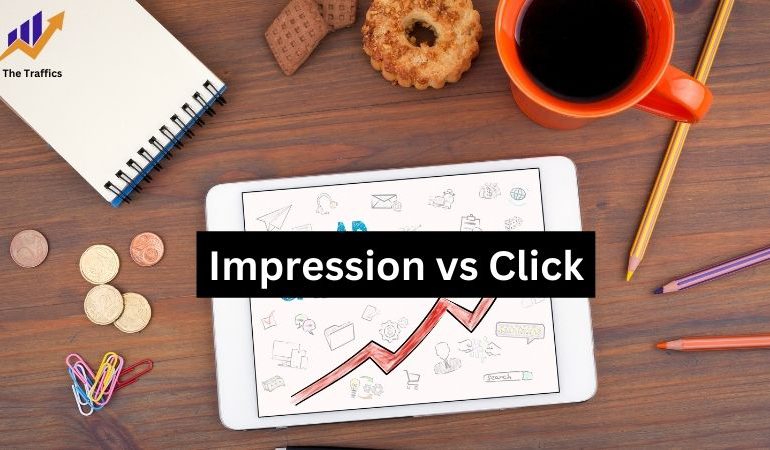Impressions vs Clicks: Which One Is Better?

In website marketing, you’ll often come across the terms “impression” and “click”. It’s important to understand what these terms mean and how they differ, especially if you’re using website marketing for your business. Depending on your goals, you’ll want to optimize your online ads to get the best results and value for your investments. This article will explain the differences between impressions vs clicks, so you can make informed decisions for your marketing strategy.
Difference Between Impressions Vs Clicks
What are impressions?
An impression in digital marketing happens when an ad appears on a screen. The user doesn’t have to actively notice or interact with the ad; just the fact that it shows up on their screen, like your website appearing in search results, is counted as an impression.
It’s important to know that impressions are not unique. If the same person sees your ad multiple times, each time is counted as a separate impression. To measure unique impressions, you need to look at reach, which is the number of unique users who see your ad.
What are clicks?
In digital advertising, a click occurs when a user not only sees your ad (impression) but also interacts with it by clicking on it. It’s like the purpose of the visit. The click takes the user from just seeing your ad to actively engaging with it, leading them to your website or landing page.
This is where they can learn more about your product or service, make a purchase, sign up for a newsletter, or complete any other action that fulfills the purpose of your ad.
Important of impressions and clicks?
Impressions
It’s important to track impressions because they tell you how many people are seeing your ad – the size of your audience. To know how many people see your ad, just check the impressions.
Impressions also help make sense of your clicks and conversions. For instance, if you get 10 clicks on an ad in a week, is that a lot? Well, it depends on the context. If you had 20 impressions that week, it means half of the people who saw your ad clicked on it, which is really high! On the other hand, if you had 1000 impressions that week, 10 clicks would be considered very low.
Clicks
Clicks provide information about how well your ad message is working. If someone clicks on your ad, it shows that the ad was interesting enough to catch their attention.
Similar to impressions, clicks can give more meaning to your other measurements. If you have many impressions but not many clicks, it suggests that you may need to make your ad message more interesting. On the other hand, if many people are clicking, it means you have created an ad that is relevant and captivating.
Why Track Impressions and Clicks?
Keeping track of impressions vs clicks provides important information about how well your marketing campaigns are doing. Impressions show how widely your ad has been seen, and clicks indicate which ads are connecting with users.
Using this data, you can adjust or improve your campaigns to reach more people and increase engagement with your ads. Comparing impressions to clicks helps you understand the success of your campaigns and what improvements can be made.
This information is extremely valuable for digital marketers as it offers insights into their audience’s behavior. Understanding the distinction between impressions and clicks helps you better monitor and evaluate the performance of your digital advertising campaigns.
Now that you know what impressions are and how they differ from clicks, you can apply this knowledge to enhance your campaigns.
How to improve impressions and clicks
1. Set your goal:
Before starting an advertising campaign, consider the purpose of your advertising and the goals you want to achieve. Ask yourself these questions to guide your planning process. Businesses often use Google Ads to generate leads or increase brand awareness. Create a roadmap outlining your strategies, set clear advertising goals, and align your efforts accordingly.
2. Find the right audience:
Always keep in mind that you’re creating ads for your visitors, not for yourself. Take the time to understand your target audience. Research their demographics, like age, gender, interests, and geographic locations, to tailor your offers to them.
For example, if you sell “handmade jewelry” and your target audience is women interested in handmade jewelry aged between 20-45 years, set up your ad campaign to specifically target that age group. This increases the likelihood of converting potential customers.
3. Choose the right platform:
Continuing with the previous example: Now that you know your target audience is women aged 20-45, determine the best online platform to grab their attention. This could be social media, Google search results, the Google Play store, Facebook, or another marketing platform.
Once you’ve identified the most effective platform, concentrate your efforts there instead of spreading them across various platforms. This approach will save you money and time, providing you with the results you desire.
4. Find the right keywords:
Keywords are the phrases users type into the search bar when making queries. For example, if you run a business providing free website traffic for a website, your keywords could be ‘free website traffic’ ‘increase website traffic‘ etc.
Make sure to include these relevant keywords in your website or ad copy. This helps you reach the right audience and makes it easier for visitors to find your website online.
5. Take help from digital marketing experts:
Creating successful Google ads can be a challenging task. Instead of spending time trying to understand metrics, developing the right marketing strategy, and diverting your attention from your business, it might be beneficial to seek assistance from digital marketing experts. They can help you create an effective ad copy, target the right audience, and build customized marketing strategies to achieve your business goals.
How can you track impressions and clicks?
Now that we’ve explained what each metric is, let’s talk about how to track them. The most effective way to monitor metrics such as impressions, clicks, and conversions is through the platform you use to run your ad campaigns. For instance, if you’re using Google Ads, use that platform to check engagement metrics and observe how users interact with your ads.
In addition to the campaign platform, you can also utilize other tools. For example, Google Analytics is a tool that provides data about user behavior on your landing pages, offering additional insights.
What metrics can you find using impressions and clicks?
Previously, we discussed how each metric can provide context for the others. However, there’s more to it. You can pair these metrics to create new ones, offering deeper insights into your ad performance.
When you compare impressions vs clicks, you calculate the click-through rate (CTR). This metric shows the percentage of your impressions that result in clicks. A high CTR indicates that a significant portion of people who see your ads end up clicking on them.
On the other hand, comparing clicks and conversions gives you the conversion rate. While conversions measure the raw number of people who convert, the conversion rate is the percentage of clicks that lead to conversions. It provides additional context to the number of conversions, helping you understand how effective your landing pages are.
Conclusion
In conclusion, The effectiveness of impressions and clicks depends on what a specific advertising campaign is trying to achieve. If the goal is to make people aware of a brand and reach a large audience, impressions are crucial. On the flip side, clicks are more valuable when the aim is to get people to interact with the ad, make purchases, or take specific actions. Often, the best approach is to find a balance between the two, taking into account the overall goals of the advertising campaign.
To increase website traffic in the ever-changing world of digital advertising, it is important to understand both metrics and thoughtfully integrate them into a marketing strategy.






